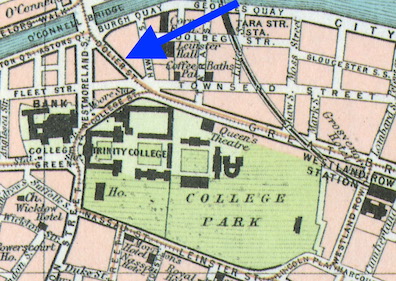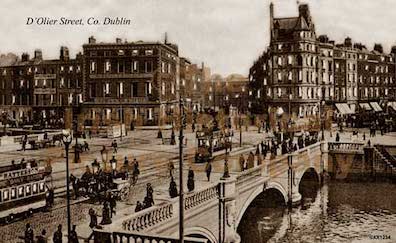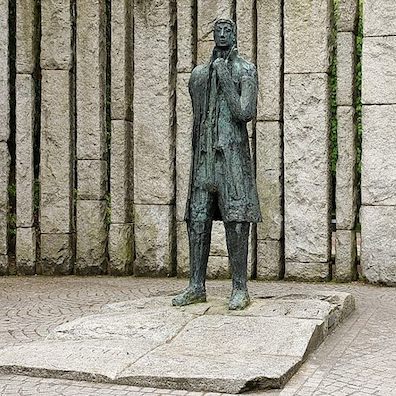Miss Dunne
New space-time. Section 7 of Wandering Rocks features Blazes Boylan’s secretary “Miss Dunne,” a woman who does not appear elsewhere in Ulysses. Her location is not specified, but a reference in Circe to “Miss Dunn at an address in D’Olier street” suggests that Boylan’s office is on that commercial street between Trinity College and the O’Connell Bridge. If so, the section is sited several blocks north of section 6, itself taking place several blocks north of section 5. Two interpolations recall section 5 and anticipate section 9. At the end of the section a telephone rings and Miss Dunne speaks with her employer––a call which Boylan was about to make at the end of section 5. Although Miss Dunne is preoccupied with upcoming times in this section, there is no indication of the present time.
With Westmoreland Street, D’Olier Street is one of two short but wide business thoroughfares leading to the important bridge at the base of O’Connell Street––Westmoreland bringing traffic from College Green and D’Olier from Great Brunswick (now Pearse) Street. In James Joyce’s Dublin Ian Gunn and Clive Hart note that a business called “The Advertising Co.” was listed at number 15 D’Olier Street in Thom’s directory, and they infer that this may be where Boylan has his office (49), since he is involved in advertising ventures. The sandwichboard men associated with him in section 5 return via an interpolation in section 7: “Five tallwhitehatted sandwichmen between Monypeny’s corner and the slab where Wolfe Tone’s statue was not, eeled themselves turning H. E. L. Y. ‘S and plodded back as they had come.” The link between interpolation and context here is obvious: both involve advertising.
“Monypeny’s corner” refers to R. W. Monypeny, “designer and embroiderer of art needlework and white wool depot” at 52-53 Grafton Street. This business sat on the corner across from St. Stephen’s Green, and the fact that the sandwichboard men “eel” themselves around 180 degrees at this intersection and head back the way they came retroactively illuminates the minor mystery posed in section 5 when they were said to be “plodding towards their goal.” Their goal is not Mr. Deasy’s historical telos but the Green, where Grafton Street ends and shoppers dissipate. Joyce clearly is aiming to create an effect of near-simultaneity, because the men appear early in section 5, heading south, several minutes before Boylan asks the shopgirl to use her telephone. In Section 7 the call begins just before the men reach St. Stephen’s Green.
A statue to Irish revolutionary patriot “Wolfe Tone” had been planned for the northwest corner of the green, across from the bottom of Grafton Street, and a foundation stone for it was laid in 1898. In part 5 of A Portrait of the Artist Stephen walks along Grafton Street in a discouraged mood and sees the foundation stone: “In the roadway at the head of the street a slab was set to the memory of Wolfe Tone and he remembered having been present with his father at its laying. He remembered with bitterness that scene of tawdry tribute.”
Not only was the statue never built, but a monumental arch was erected on the same corner in 1907, dedicated to the Fusiliers who fought in Britain’s Second Boer War––earning it the nickname “Traitors’ Arch” from generations of republicans. Honoring Tone remained a controversial proposal. Gifford notes that “When the slab was swallowed up by street widening around the green early in the 1920s, little protest was raised, but when the present monument to Wolfe Tone was erected in the northeastern corner of the green a rather sharp protest ensued.” Sharp indeed: four years after its erection in 1967, Ulster Loyalists planted a bomb that blew the sculpture into four pieces, which were later successfully reunited.
Another interpolation looks forward to section 9, echoing Tom Rochford’s demonstration of his little invention: “The disk shot down the groove, wobbled a while, ceased and ogled them: six.” This sentence appears to link up with the machinery in Boylan’s office, because immediately after the interpolation Miss Dunne is shown operating her typewriter (later she speaks into a telephone, a rarity in Dublin at this time). But as Clive Hart also notes, “Miss Dunne is concerned with ogling,” staring at the poster of Marie Kendall and contemplating the sexual appeal of that performer as well as that of Suzy Nagle (Critical Essays, 206).
This section does not mention a clock or watch but it is nevertheless filled with times. Miss Dunne types out the characters “16 June 1904,” stares at the poster, and then thinks about a coming dance, wondering “will that fellow be at the band tonight” and praying, “Hope to goodness he won’t keep me here till seven.” When Boylan calls she promises him, “I’ll ring them up after five… Then I can go after six if you’re not back. A quarter after. Yes, sir.” Suddenly remembering something, she blurts out, “That gentleman from Sport was in looking for you. Mr Lenehan, yes. He said he’ll be in the Ormond at four. No, sir. Yes, sir. I’ll ring them up after five.” Lenehan, who will be featured in section 9 of Wandering Rocks and who will indeed meet Boylan in the Ormond at four, apparently has stopped by the office in search of Boylan, learned that he is out, and left a message to meet him later in the afternoon.
John Hunt 2023
1900 Bartholomew map of Dublin with superimposed arrow showing D’Olier Street. Source: Pierce, James Joyce’s Ireland.
Photograph of unknown date looking across the O’Connell Bridge to the entrance to D’Olier Street. (Westmoreland Street opens at far right). Source: www.historicalpicturearchive.com.
The Wolfe Tone statue erected at the northeast corner of St. Stephen’s Green much later, in 1967. Source: www.atlasobscura.com.
A Remington Standard 6 typewriter from 1904. Source: themechanicaltype.blogspot.com.



